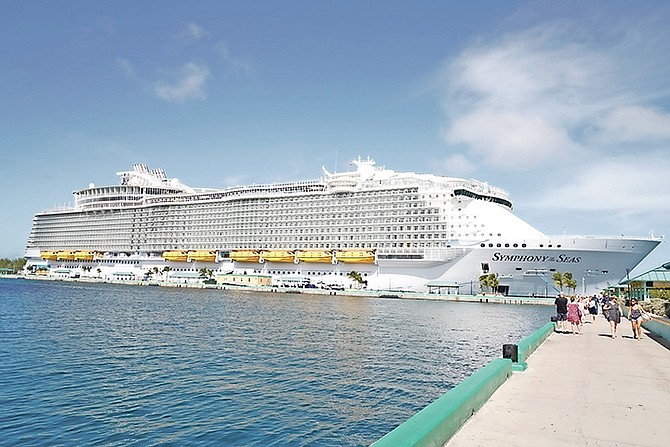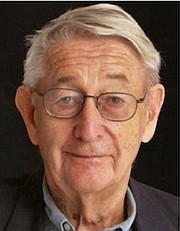By RICHARD COULSON
Our New Cruise Port: Run by Whom? Since government published over a month ago its massive Request for Proposals (RFP) to radically improve our Nassau Cruise Port, we’re wondering who’s in the running to win the job.
There’s no doubt that improvement is needed. Some 3.5 million passengers from half a dozen cruise lines pass through its gates every year, making it the largest cruise port in the Caribbean. But Nassau is popular mainly because it’s the shortest voyage from Florida’s three homeports. According to many studies, it’s one of the least appealing in the area. The recent arrival of the 5,500-passenger record-breaking Symphony of the Seas showed a range of on-board attractions that give passengers even fewer reasons to disembark into the chaotic welcoming scene of our Prince George Wharf Terminal.
Government is seeking a party to “design, build, operate, finance and invest” in a facility with increased dockage space for future cruise vessels, and it must also “propose a comprehensive upland development for improving the guest experience and increase the tourist offering.” In short, it must know both how to land more tourists and then how to entertain them.
How does government expect to find the most talented candidate for these demanding tasks, who will be granted a 25-year exclusive concession? It’s clear that a bid will be submitted by Global Ports Holding, a company listed on the London Stock Exchange and said to be controlled by Turkish interests. It has a strong track record of operating over a dozen cruise ports in Europe, including such major ones as Barcelona and Venice, and recently signed up its first Caribbean venture in Havana.
To satisfy the RFP’s requirement for “significant local participation” by resident Bahamian businesses, it has taken Arawak Port Development as a partner, the operator of our container terminal, publicly traded on BISX with a minority government stake. Local investment bank CFAL has been signed to raise equity capital from Bahamian investors. Global may have a head-start over any competitors, since it earlier submitted a 49-page “unsolicited proposal” that government used as a template for the RFP.
However, other names are appearing as probable bidders. Several major cruise companies serving Nassau recently met to organise a consortium that would build and operate the terminal, providing the initial capital and the port management expertise.
A local Bahamian initiative is planning a proposal for redevelopment of the existing docks and surrounding amenities. It would incorporate ideas evolved by Gerald Strachan’s “Culture Village” enterprise, for providing cruise and stopover passengers with experiences rooted in Bahamian heritage, culture and traditions, in conjunction with international experts in port design and management. While nothing has yet been signed, this group is receiving legal advice how to combine with the cruise ship consortium while Royal Fidelity bankers have been approached to consider the financial structure.
Competition is always good, and it’s to be hoped these varied interests can be forged together by the deadline of December 7 to submit separate or consolidated bids. Each bidder must prove financial resources of at least $100 million and clearly specify who is the “lead firm” coordinating the project. Once that’s done, these groups could offer strong competition to the experienced Global Ports Holding team.
Government has a major stake in choosing the best entry, since rebuilding the port and its environs is the only way to kick-start revitalization of down town eastern Bay Street, a decaying zombie zone ever since the removal of commercial shipping to Arawak Cay.
Bahamas Population: Growth is Needed
When I visited Singapore in 1965, it was just emerging from the Federation of Malaysia and was still a minor Third World country. Dominated by the low-lying colonial landmark The Raffles Hotel, it looked not too different from Nassau. Its population of about 1.5 million spread over a compact 280 square miles (sqm) gave it a density of 5,350 people per sqm. Today, with about 5.6 million people, the density ratio has risen to nearly 20,000. Surely, Singapore must have become a dreadfully over-crowded and unpleasant place to live, sitting on the Equator’s permanent sea-level humid heat.
Not at all. Singapore has become one of the world’s most dynamic economies, as a leading financial and trade centre and electronics exporter. It boasts an AAA sovereign bond rating and unemployment rate of 1.9 percent, and comes first on the World Bank’s ease of doing business ranking. It provides an appealing environment for its populace of entrepreneurs, business executives, small shopkeepers, and ordinary wage-earners, standing 9th on the UN Human Development Index (54th for The Bahamas).
While office towers and high-rise apartment blocks rule the central sky line, plenty of space remains for greenery and botanical gardens. The bi-ethnic Chinese-Malay citizenship works in harmony, and the immigration policy for qualified expatriates has allowed non-citizens to become over 40 percent of total population.
The key to Singapore’s success: public services that have kept pace with population growth. Electric power, water and sewage, transport network, and education are all first-rate. Private wealth is subject to an equitable income tax. All resulted from the strong political leadership of the late Lee Kuan Yew, pictured, the initial prime minister. He stamped the tradition of incorruptible hard work on the country in a way that neither British colonial rule nor subsequent independent governments have come close to achieving here.
Yet we enjoy advantages for growth potential not available to Singapore. We are not a compact society squashed between the land masses of Malaysia and Sumatra, but an archipelago of tropical islands 700 miles long with sovereignty over possibly 150,000 sqm. and a land area of only 5,380 sqm. Our population of 400,000 gives us a density of just 75 per sqm., of course higher in New Providence but still only 3,125. Uncounted miles of matchless solitary beaches grace our shorelines, and thousand of acres of land lie vacant, some arable and all within reach of cooling sea breezes.
The dispersion of population over many island communities long posed an insuperable block to economic growth, since no concentration could be achieved solely with sailing craft. This obstacle is now vanishing with electronic communication, more efficient air services and expanding networks of high-speed vessels. And within 50 years our major islands may well be linked by bridges and causeways giving full range to automotive transport.
Like Singapore, our potential cannot be realized with a static work force. Higher local birth rates and greatly increased immigration must be welcomed – provided, of course, that public services keep pace. Nostalgia for keeping all of our country physically “as is” must fade away. Downtown Nassau must be allowed to bloom with office and condo towers and population density to match Singapore, Panama, or Miami, since we have the incomparable advantage of a highly varied archipelago.
Harbour Island, the Abacos, Eleuthera, Exuma, and Cat and Long Islands can all be regulated with stiff architectural codes and zoning rules to preserve their charm and tranquility. Grand Bahamas can become another canal-crossed Ft Lauderdale suburbia, and Andros can be divided into precise agricultural districts. Our innumerable coral reefs can be preserved as magnets for undersea exploration, and as a yachting and fishing paradise.
We can rejoice that, unlike our neighbours Barbados or Dominica or St. Kitts, The Bahamas is a huge nation, as long as the entire Antilles chain, that can be both city and country, beach and ocean, farm and garden – all things to all peoples.






Comments
birdiestrachan 5 years, 5 months ago
Mr Strachan does not have a chance . doc will give it to the people who own the Arawak Cay port. because the FNM motto is the rich should get richer and the poor who cares.
The man who owns the building where they are putting the post office Is he one of the owners of Arawak Cay port. ? They have all of the information and they know how to bid. No surprise there,..
Sign in to comment
Or login with:
OpenID